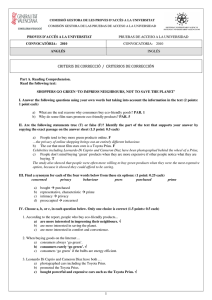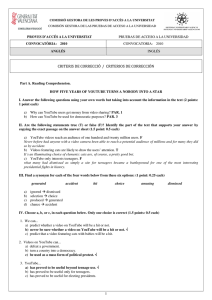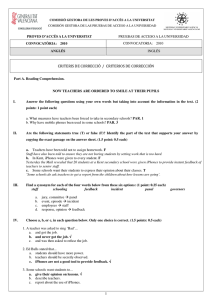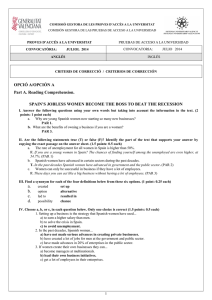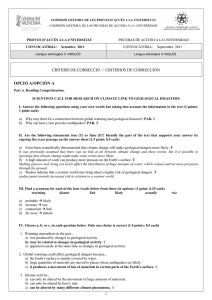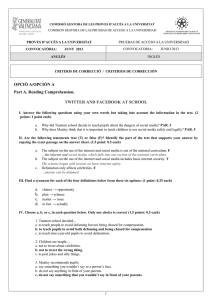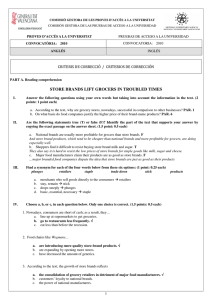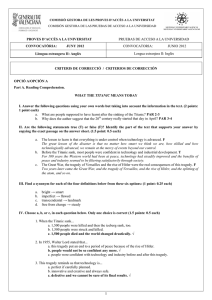chernobyl `poses more risk than fukushima`
Anuncio
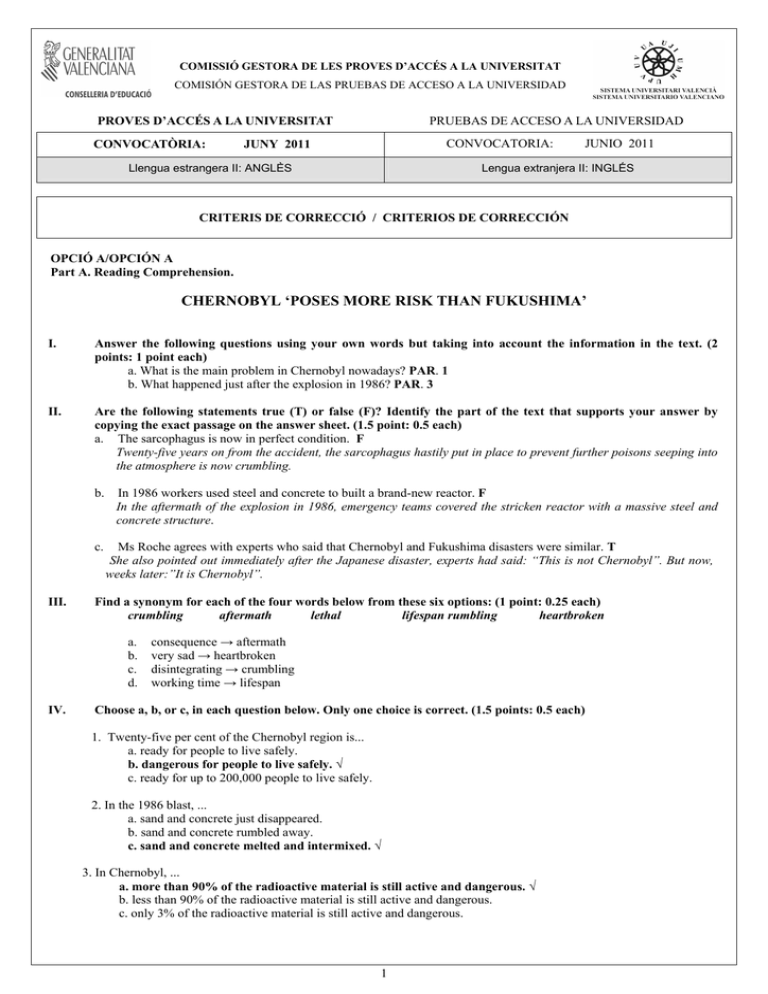
COMISSIÓ GESTORA DE LES PROVES D’ACCÉS A LA UNIVERSITAT COMISIÓN GESTORA DE LAS PRUEBAS DE ACCESO A LA UNIVERSIDAD PROVES D’ACCÉS A LA UNIVERSITAT CONVOCATÒRIA: PRUEBAS DE ACCESO A LA UNIVERSIDAD CONVOCATORIA: JUNY 2011 Llengua estrangera II: ANGLÈS JUNIO 2011 Lengua extranjera II: INGLÉS CRITERIS DE CORRECCIÓ / CRITERIOS DE CORRECCIÓN OPCIÓ A/OPCIÓN A Part A. Reading Comprehension. CHERNOBYL ‘POSES MORE RISK THAN FUKUSHIMA’ I. Answer the following questions using your own words but taking into account the information in the text. (2 points: 1 point each) a. What is the main problem in Chernobyl nowadays? PAR. 1 b. What happened just after the explosion in 1986? PAR. 3 II. Are the following statements true (T) or false (F)? Identify the part of the text that supports your answer by copying the exact passage on the answer sheet. (1.5 point: 0.5 each) a. The sarcophagus is now in perfect condition. F Twenty-five years on from the accident, the sarcophagus hastily put in place to prevent further poisons seeping into the atmosphere is now crumbling. b. c. III. In 1986 workers used steel and concrete to built a brand-new reactor. F In the aftermath of the explosion in 1986, emergency teams covered the stricken reactor with a massive steel and concrete structure. Ms Roche agrees with experts who said that Chernobyl and Fukushima disasters were similar. T She also pointed out immediately after the Japanese disaster, experts had said: “This is not Chernobyl”. But now, weeks later:”It is Chernobyl”. Find a synonym for each of the four words below from these six options: (1 point: 0.25 each) crumbling aftermath lethal lifespan rumbling heartbroken a. b. c. d. IV. consequence → aftermath very sad → heartbroken disintegrating → crumbling working time → lifespan Choose a, b, or c, in each question below. Only one choice is correct. (1.5 points: 0.5 each) 1. Twenty-five per cent of the Chernobyl region is... a. ready for people to live safely. b. dangerous for people to live safely. √ c. ready for up to 200,000 people to live safely. 2. In the 1986 blast, ... a. sand and concrete just disappeared. b. sand and concrete rumbled away. c. sand and concrete melted and intermixed. √ 3. In Chernobyl, ... a. more than 90% of the radioactive material is still active and dangerous. √ b. less than 90% of the radioactive material is still active and dangerous. c. only 3% of the radioactive material is still active and dangerous. 1 CRITERIS DE CORRECCIÓ / CRITERIOS DE CORRECCIÓN OPCIÓ B/OPCIÓN B Part A. Reading Comprehension. SPAIN: NO COUNTRY FOR THE YOUNG? V. Answer the following questions using your own words but taking into account the information in the text. (2 points: 1 point each) a. What does the author mean by ‘Spain: No country for the young?’? b. Why do young graduates look for jobs abroad? PAR. 3 VI. Are the following statements true (T) or false (F)? Identify the part of the text that supports your answer by copying the exact passage on the answer sheet. (1.5 point: 0.5 each) a. There are only jobs for exploited people in Spain. T I only see jobs for exploited interns who earn €300 (£263) a month. b. In Spain’s job market a degree is still a guarantee of a job. F It is no longer clear that a degree is useful in Spain’s paralysed job market. c. Many graduates do not tell the truth about their studies to get a job. T Many graduates lie about their education when applying for work, worried that they will be rejected for being overqualified. VII. Find a synonym for each of the four words below from these six options: (1 point: 0.25 each) scarce a. b. c. d. VIII. manual paralysed regardless plentiful advance abundant → plentiful motionless → paralysed few → scarce move forward → advance Choose a, b, or c, in each question below. Only one choice is correct. (1.5 points: 0.5 each) 1. People are exploited in Spain because they are offered salaries... a. b. c. that hardly pay for the cost of transportation. √ that do not cover the cost of transportation. and conditions to advance in their careers. 2. The difference between today’s emigrants and those in the 1960’s is that... a. b. c. today’s emigrants have got a degree. √ today’s emigrants are manual workers. today’s emigrants are aged 29. 3. In Spain... a. b. c. 44% of graduates are underqualified for their jobs. more than half of graduates are overqualified for their jobs. less than half of graduates are overqualified for their jobs. √ 2 Part B. Producció escrita. Valor total d'aquesta part 4 punts. En aquesta part es demana que els alumnes produesquen un text de 130150 paraules En aquest apartat s'ha de valorar la capacitat de comunicació de l'alumne en un anglès acceptable en expressar la seua opinió i idees sobre aspectes relacionats amb el text proposat. Caldrà valorar quant de positiu haja pogut portar a terme l'alumne i no fixar-se únicament en els errors gramaticals. Seria fonamental considerar els següents aspectes: 1. Aspectes de caràcter estratègic: amb un màxim de 0,5 punts. 2. Correcció gramatical: amb un màxim de 1,5 punts. 3. Claredat d'expressió i organització textual: amb un màxim d'1 punt. 4. Varietat, riquesa i precisió lèxica: amb un màxim d'1 punt. ORIENTACIONS PER A CORRECCIÓ DELS ASPECTES ANTERIORS 1. Aspectes de caràcter estratègic: - Presentació clara i ordenada (marges, sagnats, etc.). - Ortografia correcta. - Text distribuït en paràgrafs. - Ús correcte de signes de puntuació. - Lletra clara i comprensible. - Escrit en tinta. -… 2. Correcció gramatical: - Ordre correcte dels elements fràstics (SVO…). - Concordances correctes (S-V, pronoms referents…). - Formes pronominals correctes. - Quantificadors correctes. - Estructuració negativa correcta. - Temps i seqüències verbals adequats i correctes. - Partícules temporals adequades (FOR, SINCE, AGO, ALREADY). - Ús adequat d'articles (genèrics, específics…). - Ús correcte del possessiu. - Coneixement dels plurals irregulars. - Ús correcte de modals i defectius. - Invariabilitat dels adjectius (gènere i nombre). - Ús correcte de les preposicions. -… 3. Claredat d'expressió i organització textual: - Seqüenciació i organització del text clara i lògica. - No hi ha excessives repeticions. - No és un text confús i fosc. - Ús adequat de connectors per a les diferents idees. - Aproximació al tema coherent i original. - Estructuració de les idees en paràgrafs. -… 4. Varietat, riquesa i precisió lèxica: - No s'usen paraules en espanyol ni inexistents. - Elecció de termes específics i concrets per a aqueix text. - No existeix confusió entre elements lèxics bàsics. - No hi ha confusió entre categories gramaticals. - No existeix un abús desmesurat d'expressions idiomàtiques. 3 Parte B. Producción escrita. Valor total de este apartado 4 puntos. En esta parte se pide que los alumnos produzcan un texto de 130-150 palabras. En este apartado se ha de valorar la capacidad de comunicación del alumno en un inglés aceptable al expresar su opinión e ideas sobre aspectos relacionados con el texto propuesto. Habrá que valorar cuanto de positivo haya podido llevar a cabo el alumno y no fijarse únicamente en los errores gramaticales. Sería fundamental considerar los siguientes aspectos: 1.- Aspectos de carácter estratégico: con un máximo de 0,5 puntos. 2.- Corrección gramatical: con un máximo de 1,5 puntos. 3.- Claridad de expresión y organización textual: con un máximo de 1 punto. 4.- Variedad, riqueza y precisión léxica: con un máximo de 1 punto. - ORIENTACIONES PARA CORRECCIÓN DE LOS ASPECTOS ANTERIORES 1.- Aspectos de carácter estratégico: - Presentación clara y ordenada (márgenes, sangrados etc.) - Ortografía correcta. - Texto distribuido en párrafos. - Uso correcto de signos de puntuación. - Letra clara y comprensible. - Escrito en tinta. -… 2.- Corrección gramatical: - Orden correcto de los elementos frásticos (SVO…) - Concordancias correctas (S-V, Pronombres referentes…) - Formas pronominales correctas - Cuantificadores correctos - Estructuración negativa correcta - Tiempos y secuencias verbales adecuados y correctos - Partículas temporales adecuadas (FOR, SINCE, AGO, ALREADY) - Uso adecuado de artículos (genéricos, específicos…) - Uso correcto del posesivo - Conocimiento de los plurales irregulares - Uso correcto de modales y defectivos - Invariabilidad de los adjetivos (género y número) - Uso correcto de las preposiciones -… 3.- Claridad de expresión y organización textual: - Secuenciación y organización del texto clara y lógica - No hay excesivas repeticiones - No es un texto confuso y oscuro - Uso adecuado de conectores para las diferentes ideas - Aproximación al tema coherente y original. - Estructuración de las ideas en párrafos. -… 4.- Variedad, riqueza y precisión léxica: - No se usan palabras en español ni inexistentes - Elección de términos específicos y concretos para ese texto - No existe confusión entre elementos léxicos básicos - No hay confusión entre categorías gramaticales. - No existe un abuso desmesurado de expresiones idiomáticas. 4
